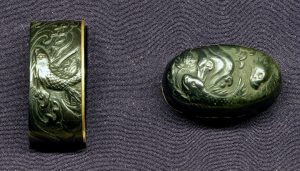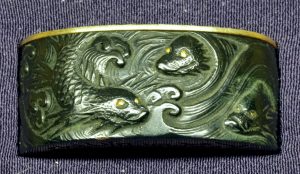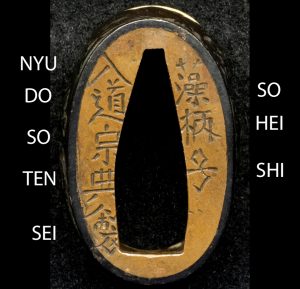F/K / SOTEN / DRAGONFISH (SHACHI) / $2350
DRAGONFISH F/K
LARGE SOTEN FUCHI / KASHIRA
SHACHI 鯱 (DRAGONFISH)
NBTHK TOKUBETSU HOZON
MEI: SOHEISHI · NYUDO SOTEN SEI
FUCH: 1.625” X 1” X 0.75”
ANA: 1.1875” X 0.375”
KASHIRA: 1.5” X 0.875”
-School history from Sesko’s, Toso Kinko Schools
The Sōten school is commonly classified as tankō (鐔工), that means in the category of tsuba craftsmen who worked in iron. But because they also made some softmetal works and were very productive, I took the opportunity to introduce them here. Founder of the Sōten school was Kitagawa Zengorō (喜多川善五郎) who lived in Kyōto ́s Hachiman district (八幡町). His family name „Kitagawa“ is also written with the characters (喜多河). Old sources like the „Sōken- kishō“ say that he first used the craftsman name „Shūten“ (秀典) before he was active under the name of „Sōten“ (宗典) in Nakajiki (中敷) in Ōmi ́s Hikone (彦根). But it is unclear if Shūten and Sōten were really the same artist. Today it is assumed that Sōten used the latter name first as the „normal“craftsman name and so the Japanese reading „Munenori“ was applied. Later when he entered priesthood he kept the name and read it as his nyūdō-gō as „Sōten“. The characteristic style of Sōten, i.e. detailed figures accentuated with gold iroe on an iron tsuba with or without sukashi, became famous throughout the country under the name „Hikone-bori“ (彦根彫) and was very popular during the Edo period. As a result, many forgeries and „well-meant“ copies were produced. This trend was joined by the fact that the works of later generations and Sōten students lack more and more attention to detail and so works from the Sōten school in general have been evaluated rather low in more recent publications. Anyway, the gō „Sōheishi“ (藻柄子) which is also read „Mogarashi“ was probably used by the direct mainline students or members of the Kitagawa family.
The meikan records mostly list a 2nd gen. Sōten but works of the two are virtually indistinguishable. There is a work extant which probably goes back to the 1st gen. because it is dated Kan ́en three (1750) in combination with the information „made at the age of 72“. So his year of birth may be calculated to Enpō seven (1679). The 2nd gen. is traditionally dated after the Kan ́en era, i.e. around Hōreki (1751-1764) and Meiwa (1764-1772).
In the following I would like to introduce some of the more well- known Sōten students. First, there were Munekata (宗賢, also read „Sōken“), whose first name was „Zengorō“ (善五郎), Munehide (宗秀, also read „Sōshū“), called „Zengorō“ too and with the gō „Ryūsōshi“ (竜藻子), Munehide ́s son Zengorō Hidetsugu (善五郎秀次), and Sō ́un (宗運), who used the gō „Shusōshi“ (主藻子). All of them belonged to the Kitagawa family. Kanenori (包教), whose civilian name was „Nomura Saburōji“ (野村三郎次) and who is also listed with the first name „Saburōbei“ (三郎兵衛), was a student of the 1st gen. Sōten. He used the gō „Kan ́eishi“ (干英子). By the way, it is said that the craftsman name „Kanenori“ was read back then as „Masanori“. The Sōten style was continued by Kanenori ́s student Ōchi Sōkurō (大地 宗九郎) who used the craftsman name „Muneaki“ (宗顕, also read „Sōken“) and the gō „Yūmeishi“ (幽明子). Muneaki also bore the family name of his master, i.e. „Nomura“.
A Sōten branch was formed by the Tsutsui family (筒井). We know Tsutsui craftsmen like Yoshihiro (吉広), first name „Yoshihiro“ (芳広), Yoshitake (吉武), according to transmission a student of the 2nd gen. Sōten, and Yoshifusa (吉房), who bore the first name „Yoshifusa“ (芳房) and the gō „Sōheishi“ and „Kotōken“ (湖東軒).
Another Sōten student who worked in the style of the school but who also displayed his own interpretations was Kanetane (兼胤). Kanetane ́s civilian name was „Yoshikawa Hei ́emon“ (吉川平右衛門) and he also signed with the gō „Sōheishi“.
The Iriyama family (入山), another Sōten branch, used successively the gō „Zaichōshi“ (財彫子). Representative craftsmen of the Iriyama line were for example Yoshitomo (喜知), Munehide (宗英), Yoshishige (義重), and Yoshichika (義近, also read „Gikin“), who also signed besides „Zaichōshi“ with the pseudonym Nikuborishi“ (肉彫子) and his craftsman name „Yoshichika“ also with the characters (義親).
___________________________
This truly is a rare set of fittings. It is rare to find Soten work in shakudo or any soft metals as they typically worked in iron as mentioned above. The large size is also somewhat rare. The length and width are not necessarily oversized, but they are 0.75” tall which is outside the standard size.
This rare and wonderful F/K set comes in a custom box and NBTHK Tokubetsu Hozon kanteisho.
$2350 plus S/H
REDUCED
$1975 plus S/H






